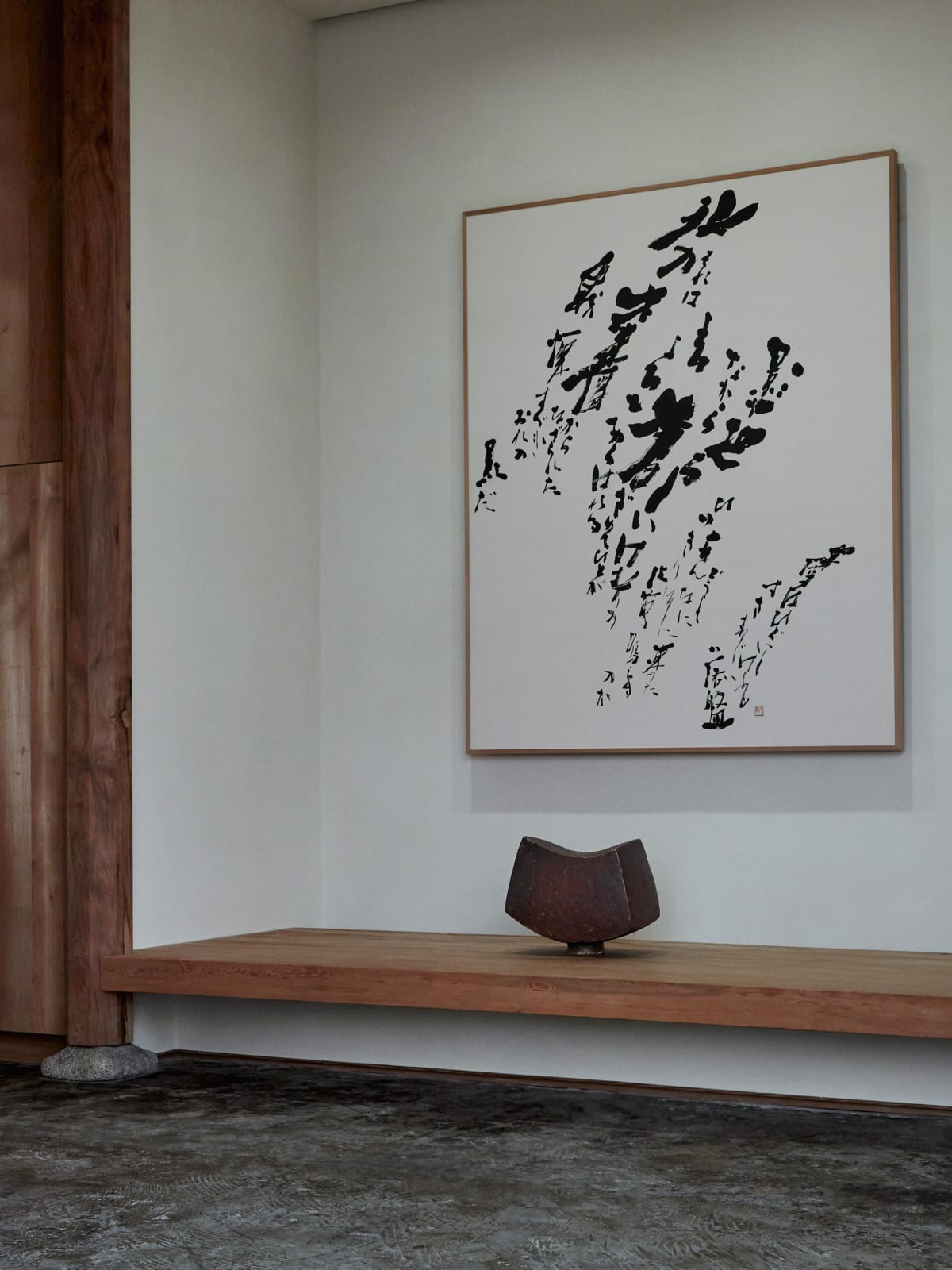Morita Shiryū (1912–1998)
Shadow from the Future
Ink on paper, framed
1949
With a label signed by Inada Sousai
Seal: Shiryu
148 x 121 cm
151 x 124 cm (overall)
1949
With a label signed by Inada Sousai
Seal: Shiryu
148 x 121 cm
151 x 124 cm (overall)
Further images
Exhibitions
Survey of Japanese Calligraphy Exhibition. Tokyo: Tokyo Metropolitan Art Museum, 1949.Literature
The Works of Shiryu Morita: Selected by the Artist. Kyoto: Bokubisha, 1971.
The text of this early work quotes the poem Shadow from the Future from Miyazawa Kenji’s publication Spring and Asura (Second Collection). Written from top to bottom in lines from right to the left, it reads:
The blizzard drives hard / and this morning another catastrophic cave-in /
. . . Why do they keep blowing / the frozen whistle?. . . /
Out of the shadows and the horrible smoke / a deathly pale man appears, staggering— /
the frightening shadow of myself / cast from a future of ice. (trans. Hiroaki Sato, 2007)
Morita Shiryu at that time began turning away from the conventional calligraphy scene. As he recalled later, his mentor Ueda Sokyu advised against publicly showing the present work. At the Second Mainichi Calligraphy Exhibition in the same year, the calligrapher Morita Yasuji, also a student of Ueda Sokyu, received the special prize for Matasaburo the Wind Imp. The work consisted mainly of onomatopoetic repetitions of the syllable do and za to evoke the sound of the wind and the rain, interspersed with seemingly erratic fragments of sentences such as “the sweet pomegranate is blown away, the bitter pomegranate is blown away” and the proper names Matasaburo and Amesaburo. Compared to Morita Yasuji’s more regular flow, Morita Shiryu in his Spring and Asura interpretation bends his characters widely here and there, accentuating the questioning style of his source text. Morita was perhaps ahead of his time, and this may have also been the true reason for Ueda Sokyu’s reservation. But then again, leaping into uncharted territory was what he felt he had to do.
Morita Shiryu (avant-garde calligrapher; 1912–1998)
Avant-garde calligrapher from Hyogo Prefecture. Like fellow artist Inoue Yuichi, Morita studied under the calligraphy master Ueda Sokyu. He co-founded the avant-garde group Bokujinkai together with Inoue and was the founder and editor of the journal Bokubi (Beauty of Ink), both of which revolutionized traditional Japanese calligraphy and spread knowledge of Japanese avant-garde calligraphy to an international audience. He was posthumously awarded the Medal of Honor with Dark Blue Ribbon.
The blizzard drives hard / and this morning another catastrophic cave-in /
. . . Why do they keep blowing / the frozen whistle?. . . /
Out of the shadows and the horrible smoke / a deathly pale man appears, staggering— /
the frightening shadow of myself / cast from a future of ice. (trans. Hiroaki Sato, 2007)
Morita Shiryu at that time began turning away from the conventional calligraphy scene. As he recalled later, his mentor Ueda Sokyu advised against publicly showing the present work. At the Second Mainichi Calligraphy Exhibition in the same year, the calligrapher Morita Yasuji, also a student of Ueda Sokyu, received the special prize for Matasaburo the Wind Imp. The work consisted mainly of onomatopoetic repetitions of the syllable do and za to evoke the sound of the wind and the rain, interspersed with seemingly erratic fragments of sentences such as “the sweet pomegranate is blown away, the bitter pomegranate is blown away” and the proper names Matasaburo and Amesaburo. Compared to Morita Yasuji’s more regular flow, Morita Shiryu in his Spring and Asura interpretation bends his characters widely here and there, accentuating the questioning style of his source text. Morita was perhaps ahead of his time, and this may have also been the true reason for Ueda Sokyu’s reservation. But then again, leaping into uncharted territory was what he felt he had to do.
Morita Shiryu (avant-garde calligrapher; 1912–1998)
Avant-garde calligrapher from Hyogo Prefecture. Like fellow artist Inoue Yuichi, Morita studied under the calligraphy master Ueda Sokyu. He co-founded the avant-garde group Bokujinkai together with Inoue and was the founder and editor of the journal Bokubi (Beauty of Ink), both of which revolutionized traditional Japanese calligraphy and spread knowledge of Japanese avant-garde calligraphy to an international audience. He was posthumously awarded the Medal of Honor with Dark Blue Ribbon.





